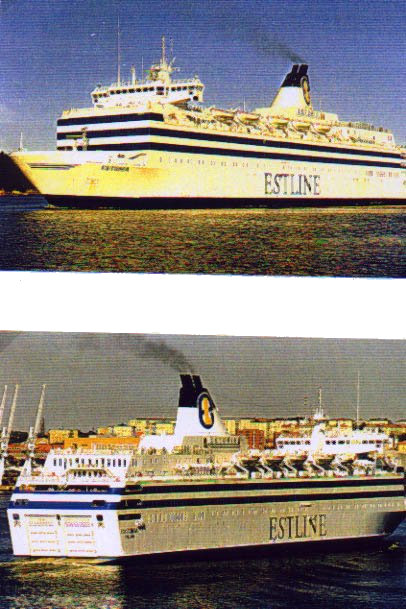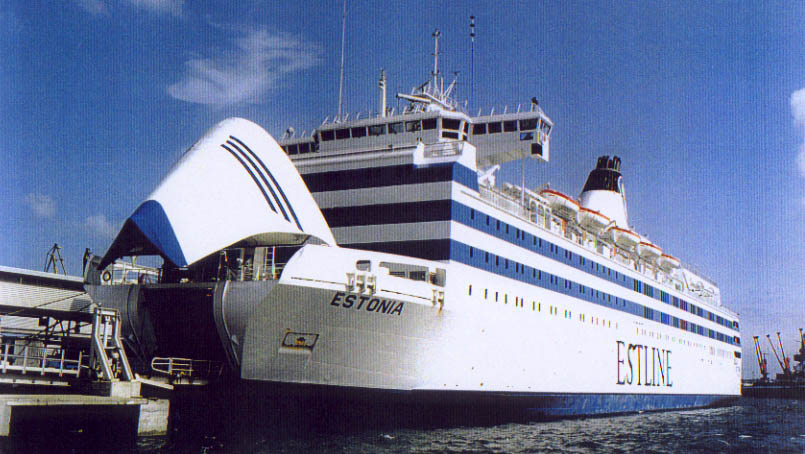
6.5.2
In Tallinn
The vessel was moored alongside Baltic Shipyard and considerable inspections were carried out by the representatives of B.V.:
- Hans Olsson
- Anders Wirstam
- somebody from the head office, Paris - probably J.-F. Segretain - Manager of the Marine Departmentand by the inspectors of Sjöfartsverket, Stockholm:
- Tom Evers
- Johann Båth
- Stellan Johansson
- Ari Niemenenand by various representatives of the E.N.M.B. as well as ESCO and N&T.
The findings of B.V. are summarised in the "Survey Report for Issue (1) for Passenger Ship Safety Certificate" dated 07.02.93, which is attached as Enclosure 6.5.2.125.
The report mentions for example under 'General Information' on page 1:«Does the vessel proceed more than 20 miles from the nearest land, in the course of her voyage? (Reg. 1 (c), Chapter II)? Yes.»
In the SOLAS edition in force in January 1993, which included the SOLAS 1974 edition plus subsequent addenda, no Regulation 1 (c) in Chapter II can be found anymore, i.e. the B.V. form is based on an older edition of SOLAS 1974 when Reg. 1 (c) - which is now Regulation 1.4. - contained the following:
«Chapter II-1
Construction - Subdivision and Stability,
Machinery and Electrical Installations
Part A General
Regulation 1(c) The Administration may, if it considers that the sheltered nature and conditions of the voyage are such as to render the application of any specific requirements of this chapter unreasonable or unnecessary, exempt from those requirements individual ships or classes of ships belonging to its country which, in the course of their voyage, do not proceed more than 20 miles from the nearest land.»
Consequently it should have been obvious for B.V. that it was not possible to grant any exemption whatsoever as "the vessel proceeded more than 20 nm from the nearest land in the course of her voyage." As the wording of Regulation 1 (c) is more or less identical to Regulation 1.4. of the 1992 edition of SOLAS 1974 the application of the older form did not make a difference.
The report continues with item 2 - Survey of Hull and Machinery»2.1. Has an inspection of the structure been carried out? Yes, 1-93.«
This item is the only one, where the B.V. form does not quote any SOLAS Regulation.
»3. Stability Chapter II-1, Reg. 7 - 19-20
Is the master supplied with the necessary documents concerning stability? Yes.
(Approved by the Finnish Authorities, pending B.V. approval).«Here B.V. correctly did not accept the "Stability Booklet" approved by the F.B.N., because there were indications that it could not comply with all requirements (see Subchapter 6.4).
On the other hand B.V. accepted the structure of the vessel approved by F.B.N. including the location of the bow ramp as upper extension of the collision bulkhead, although this was obviously not in accordance with the requirements of SOLAS because the ramp was visibly located too much forward. It did not require a detailed structural examination to find that out but just the knowledge of the structure of the vessel which a Classification Society should have after 12 years of attendance to a vessel built under its supervision! Knowledge of the relevant SOLAS requirements Mr. Olsson and the man from Paris definitely should have had, as the SOLAS rules had then already been part of the B.V. rules for about 10 years. B.V. now argues in defence that the vessel in her previous trade had also proceeded more than 20 nm from the nearest land - which is true for the leg Vaasa-Sundsvall - and thus they could assume that the structure had been approved by F.B.N. to be in conformity with SOLAS 1974 requirements.SOLAS Regulation 12, however, requires:
»A certificate called a Passenger Ship Safety Certificate shall be issued after inspection and survey to a passenger ship which complies with the requirements of Chapters II-1, II-2, III and IV and any other relevant requirements of the present Regulation.«
and Chapter II-1, Regulation 9 (ii) requires:
»If the ship has a long forward superstructure, the forepeak bulkhead shall be extended weathertight to the deck next above bulkhead deck. The extension need not be fitted directly over the bulkhead below, provided it is at least 5 per cent of the length of the ship from the forward perpendicular, and the part of the bulkhead deck which forms the step is made effectively weathertight.«
Nevertheless B.V. issued an (Interim) PSSC confirming that the vessel did comply with SOLAS in every respect.
After the casualty, B.V. has explained this in their letter to the JAIC dated 10.01.95 - see Enclosure 2.4.3.37 - as follows:
»D-change of flag in February 1993 D1 Bureau Veritas authorisations for Estonian flag vessels Bureau Veritas received as of 18 August 1992 authorisation from the Government of Estonia to issue certificates pursuant to the following conventions:
Load Line 1966
SOLAS 1974
MARPOL 1973
Tonnage 1969The following documents were issued to the vessel:
International Load Line Certificate
Passenger Ship Safety Certificate
International Oil Pollution Prevention Certificate
International Tonnage Certificate 1969
Attestation Pursuant to the Helsinki Convention 1974 (Prevention of Pollution by Sewage).D2 Surveys carried out by Bureau Veritas
The vessel had valid International Certificates and kept the Bureau Veritas Class when applying to fly the Estonian flag.
A periodical survey pursuant to SOLAS 1974, consolidated edition 1992, Chapter I, Part B, Regulation 7 (b) (ii) was carried out by Bureau Veritas on behalf of the Estonian Government according to the transfer of flag clauses of the Agreement signed 18 August 1992 between the Estonian Maritime Administration and Bureau Veritas.
The Exemption Certificate granted by the Finnish Authorities for radiotelegraphy (hours of listening by operator) was not re-issued under Estonian flag.
In the course of the periodical survey carried out by Bureau Veritas, a few anomalies were detected and notified to the Finnish Authorities.
E Renewal of certificates as from 1993.
The ship was surveyed and certificates renewed during the period 1993 - 1994.
The Passenger Ship Safety Certificate was kept interim pending completion of the vessel's new loading cases.«This means that a representative from the B.V. head office Paris together with the B.V. manager for Sweden, Hans Olsson, have carried out a "Periodical Survey pursuant to SOLAS 1974, consolidated edition 1992, Chapter I, Part B, Regulation 7 (b) (ii)", where it is stated:
»7. Survey of Passenger Ships
(b) The surveys referred to above shall be carried out as follows:
(ii) The periodical survey shall include an inspection of the structure .... The survey shall be such as to ensure that the ship, as regards the structure .... is in satisfactory condition ... and that it complies with the requirements of the present regulations, ...«It is obvious that a survey in compliance with this regulation cannot have been conducted. Insofar the statement of B.V. must be untrue.
It is furthermore questionable whether B.V. was entitled to carry out just a periodical survey, because Regulation 14 - Duration and Validity of Certificates states under»(g) A certificate shall cease to be valid:
(ii) upon transfer of the ship to the flag of another Government. A new certificate shall only be issued when the Government issuing the new certificate is fully satisfied that the ship is in compliance with the requirements of Regulation 11 (a) and (b) of this chapter.«Regulation 11 (a) Maintenance of condition after survey - requires:
»The condition of the ship and its equipment shall be maintained to conform with the provisions of the present regulations to ensure that the ship in all respects will remain fit to proceed to sea without danger to the ship or persons on board.«
This 'Group of Experts' consequently concludes from the above that Bureau Veritas in its capacity as mandatary of E.N.M.B. has on 07.02.1993 issued an - Interim - Passengership Safety Certificate for M.V. ESTONIA in obvious violation of the relevant regulations of SOLAS.
Note:
When the co-operation between B.V. and Sjöfartsverket in connection with the flag change procedure was discussed with Ulf Beijner - the head of the Sjöfartsverket Inspection office Stockholm at that time and in this capacity in charge of the ESTONIA matter - he fully agreed to the developments and sequence-of-events explained on the previous pages, but when it came to the causative connection between the missing "partial collision door" and the catastrophe, he strongly rejected this connection with reference to the explosion hole in the starboard side in way of the 0-deck, which in his opinion was the cause of the sinking.
The findings of the Sjöfartsverket inspectors - as far as available here - can be taken from the handwritten remarks made on pages A - J between 04.01.93 at Turku and 21.01.93 in Tallinn and on 21.03.93, when the vessel was again in Turku. These remarks - 9 pages - are attached as Enclosure 6.5.2.126 and indicate that at least part of the relevant safety installations had not been in proper condition. It has to be assumed that the deficiencies were rectified prior to Sjöfartsverket approving the vessel, although some of the items either still existed or had reappeared when Åke Sjöblom and his colleague inspected the vessel with their trainees shortly before the last departure. See Chapter 15.
In addition to a large number of safety checks the Sjöfartsverket inspectors also had an "Operational Control" performed by the new crew of the ESTONIA which consisted of a fire drill and an abandon ship drill. Details can be taken from Enclosure 6.5.2.127 - Operational Control ESTONIA.
On 2 February 1993 ESTONIA finally departed from Tallinn with representatives from authorities, B.V. and Sjöfartsverket on board. At sea a function test of ship and crew was successfully carried out and after 2 hours the voyage to Stockholm was resumed. ESTONIA looked perfect as can be seen from the following three photos.


![]()